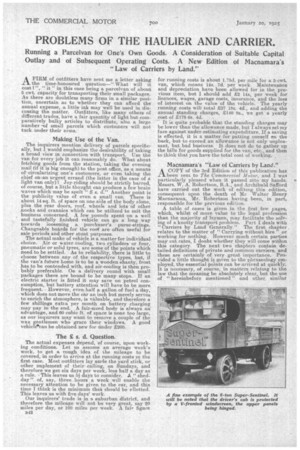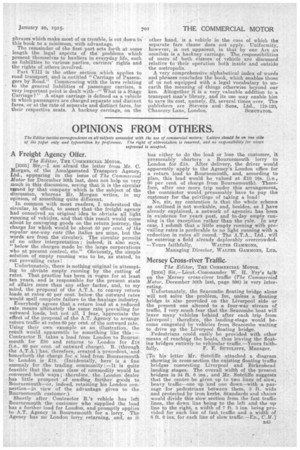• PROBLEMS OF THE HAULIER AND. CARRIER.
Page 26

Page 27

If you've noticed an error in this article please click here to report it so we can fix it.
Running a Parcelvan for One's Own Goods. A Consideration of Suitable Capital Outlay and of Subsequent Operating Costs. A New Edition of Macnamara's "Law of Carriers by Land."
AA FIRM of outfitters have sent me a letter asking the time-honoured question—" What will it cost ? ", " it " in this case being a parcelvan of about 5 cwt. capacity for transporting their small packages. As there are doubtless many firms in a similar position, uncertain as to whether they can afford the annual expense, a little ink may well be used in discussing the matter. Outfitters, like many others of different trades, have a fair quantity of light but comparatively bulky articles to distribute, also a large number -of small parcels which customers will not tuck under their arms.
Making Use of the Van.
The inquirers mention delivery of parcels specifically, but 1. would emphasize the desirability of taking a broad view in connection with transport. Use the van for every job it can reasonably do. What about fetching goods from the station, taking the evening mail (if it is big enough) to the post office, as a means of' circularizing one's customers, or even taking the chief on an urgent errand (the latter in the case of a light van only)? Joy-riding should be strictly barred, of course, but a little thought can produce a few brain waves which may be spelt " 2 s. d." Another point is the publicity value of even a small van. There is about 14 sq. ft. of space on one side of the body alone, plus the rear doors, roof, wheels and lots of other nooks and crannies which can be utilized to suit the business concerned. A few pounds spent on a well and tastefully finished vehicle can go a long way towards loosening a purchaser's purse-strings. Changeable boards for the roof are often useful for sale periods and other stunt purposes.
The actual make. of vehicle is a matter for individual choice. Air or water-cooling, two cylinders or four, pneumatic or solid tyres, are some of the points which need to be settled. • As to reliability, there is little to choose between any of the respective types, but, if the van's future home is to be a wooden shanty, frost has to be contended with, and air-cooling is then probably preferable. On a delivery round with small packages there are bound to be many stops. If an electric starter is fitted it may save on petrol consumption, but battery attention will have to be more frequent. However, even half a gallon of fuel a day, which does not move the car an inch but merely serves to enrich the atmosphere,. is vklua.ble, and therefore a few shillings extia per month on battery charging may pay in the end. A fair-sized body is always an advantage, and 60 cubic ft. of space is none too large, as our inquirers may want to remove a couple of the wax gentlemen who grace their windows. A good vehiclecan be obtained new for under 2200.
The £ S. d. Question.
The actual expenses depend, of course, upon working conditions. Let us assume an average week's work, to get a rough idea of the mileage to be covered, in order to arrive at the running costs in the first case. Most outfitters lay aside the yard stick, or other implement of their calling, on Sundays, and therefore we get six days per week, less half a day as a rule. This leaves us 5A days to consider. A " shedday " of, say, three hours a week will enable the necessary attention to be given to the car, and this time I think is the minimum that should be allotted. This leaves us with five days' work.
Our inquirers' trade is in a suburban district, and therefore the mileage will not be very great, say 20 miles per day, or 100 miles per week. A fair figure B42 for running costs is about 1.75d. per mile for a 5-cwt. van, which means 14s. 7d. per week. Maintenance and depreciation have been allowed for in the previous item, but I should add 22 14s. per week for licences, wages, garage costs, insurance, and the loss of interest on the value of the vehicle. The yearly running costs will total 237 18s, 4d., and adding the annual standing charges, 2140 8s., we get a yearly cost of 2178 6s. 4d. .
— It is quite probable that the standing charges may be lower than the allowance made, but. 1 always set my face against under-estimating expenditure. If a saving is effected, it is a matter for patting oneself en the back, but to exceed an allowance is not only unpleasant, but bad business. It does not do to gather up the bills for goods supplied for the van, etc_ ,.. and then to think that you have the total cost of working.
Macnamara's "Law of Carriers by Land."
ACOPY of the 3rd Edition of this publication has been sent, to The Commercial Motor, and I was particularly pleased when it passed into my hands. Messrs. W. A. Robertson, B.A. and Archibald Safford have carried out the work Of editing this edition, consequent upon the death of Mr Walter Henry Macnarama,' -11,Ir. Robertson having been,in part, responsible for the previous edition.
A table of cases is given in the first few pages, which, whilst of more value to the legal profession than the majority of laymen, may facilitate the solving of a knotty transport problem. Part I deals with "Carriers •by Land Generally." The first chapter relates to the matter of " Carrying without hire " or working for nothing. However much certain parties may cut rates; I doubt whether they will come within this category. The next two chapters contain detailed definitions of private and common carriers, and these are certainlyof very great importance. Provided a little thought is given to the phraseology employed, the essential points can be arrived at quickly. It is necessary, of course, in matters relating to the law that the meaning be absolutely clear, but the use of " hereinbefore mentioned" and other. similar
phrases which make most of us tremble, is cut down in this book to a minimum, with advantage. The remainder of the first part sets forth at some length the legal aspects of the problems which present themselves to hauliers in everyday life, such as liabilities to various parties, carriers' rights and the rights of others involved.
Part VIII is the other section which applies to road transport, and is entitled "Carriage of Passengers by Road." Commencing with the laws relating • to the general liabilities of passenger carriers, a very important point is dealt with—" What is a Stage Carriage?" A stage carriage is defined as a vehicle in which passengers are charged separate and distinct fares, or at the rate of separate and distinct fares, for their respective seats. A hackney carriage, on the other hand, is a vehicle in the case of which the separate fare clause does not apply. Uniformity, however, is not apparent, in that by one Act an omnibus is a hackney carriage. The responsibilities of users of both classes of vehicle are discussed relative to their operation both inside and outside the metropolis. A very comprehensive alphabetical index of words and phrases concludes the book, which enables those of us not equipped with a legal vocabulary to unearth the meaning of things otherwise beyond our ken. Altogether it is a very valuable addition to a transport man's library, and its use may enable him to save its cost, namely, £2, several times over. The publishers are Stevens and Sons, Ltd., 119-120,
Chancery Lane, London. &IMITATOR.






























